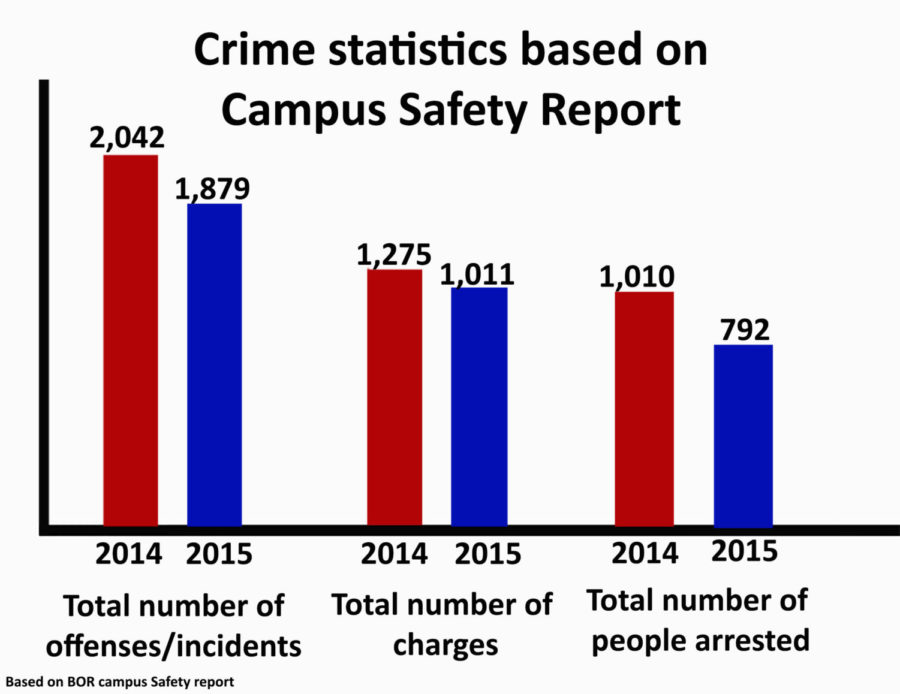- News
- News / Politics And Administration
- News / Politics And Administration / Campus
- News / Politics And Administration / State
Campus safety report shows decline in crime at Iowa State
Katy Klopfenstein/Iowa State Daily
Total number of arrests, charges and incidents for the years of 2014 and 2015 at Iowa State University.
April 6, 2016
The seventh annual report on campus safety and security, which outlines the 2015 fiscal year, was released Monday and presented by the Campus Safety and Security Sub-Committee of the Iowa Board of Regents on Wednesday.
The report includes information from all three Iowa public universities: Iowa State, the University of Iowa and the University of Northern Iowa, where topics such as mass communications capabilities, physical security capabilities and crime statistics are addressed.
Crime statistics
The report issued a summary of the number of offenses, total charges and total arrests by quarter for the 2014 and 2015 calendar years among all three universities.
The report states that there were 1,879 offenses at Iowa State in 2015, compared to 2,042 offenses in 2014. Out of those offenses, there were 1,011 charges in 2015, 264 less than 2014. Out of the 1,011, 792 ended in arrests, according to the report.
Compared to Iowa and Northern Iowa, where 20 percent of the offenses resulted in arrests, 42 percent of Iowa State’s offenses resulted in an arrest.
The document also included the number of charges brought against students and the number of alcohol-related charges out of the total charges.
“Alcohol-related charges include: public intoxication, operating while intoxicated, possession of alcohol under legal age, open container, bootlegging, providing liquor to a minor and attempting to purchase alcohol by minor and serving/selling alcohol after hours,” the report stated.
66 percent of charges were against ISU students, and 35 percent of the charges were alcohol-related and student involved. Only 13 percent of student charges were alcohol-related at Iowa, and 17 percent of student charges were alcohol-related at Northern Iowa.
At a glance
Iowa State has 37 sworn, state-certified officers, while Iowa has 34 and Northern Iowa has 18. All three universities employ part-time students who assist the police departments with dispatch and other related duties, according to the report.
The number of community service officers and number of hours of security staffing also increased at Iowa State. A full-time department supervisor was also assigned to the College of Veterinary Medicine.
Iowa State also recently finalized implementation of on-call sexual assault nurse examiners, increased the number of doors controlled by electronic access systems and increased the number of digital cameras across campus.
In regard to mass communication, “two situations required the issuance of an emergency warning message to community members” during the 2015 calendar year, the result of both alerts convening to a successful resolution, according to the report.
Social media was also touched on in the report, which stated that Twitter and Facebook were initiated in 2013 to create positive interactions with the community. They are deemed effective with the department having approximately 4,838 likes on Facebook and 7,018 followers on Twitter.
“These two applications are used extensively to provide timely, accurate and useful information on a daily basis as well as during dynamic situations,” the report stated.
The ISU Police Department has also started using Instagram within the past few weeks.
On threat assessment and management, the report stated that both Iowa and Northern Iowa have had a Threat Assessment Team (TAT) implemented, which works to “proactively prepare the campus to manage situations and issues that may threaten the safety and security of students.”
Iowa State, which has used a Threat Assessment and Management System (TAMS) for more than 20 years, also works to manage and reduce potential threats.
ISU officers responded to 190 welfare checks and 772 incidents involving suspicious people and/or activity in 2015, according to the report.
Both Iowa State and Iowa are in a mutual aid agreement with other law enforcement agencies in the area, which allows officers to work collaboratively with other agencies to ensure safety in the community.
Northern Iowa regularly meets with Cedar Falls police to discuss active cases and problems within and around the campus, the report stated.
In regard to physical security capabilities, Iowa State has installed more than 600 cameras in public areas throughout campus buildings, according to the report.
“These have proven to be effective tools for deterrence and identification,” the report stated.
In the 2015 calendar year, ISU officers provided 282 prevention and outreach programs to faculty, staff and students, instructing approximately 37,673 people, according to the report.
The programs addressed topics such as workplace violence, personal safety, alcohol laws, sexual assault awareness, social media safety, etc.
No information was provided for Iowa State regarding the training of public safety personnel.
However, ISU Police exceeded national accreditation standards in their instruction regarding departmental use of force policies and federal laws, along with qualifying officers with their issued sidearms.
No officers discharged their firearms, according to the report, except for during approved training purposes and with a single exception of dispatching a severely injured deer.
In regard to student involvement, such as the safety escort program, which has been operated by ISU Police for about 18 years, the service provided 6,279 safety escorts in 2015, 316 less than 2014, according to the report.







